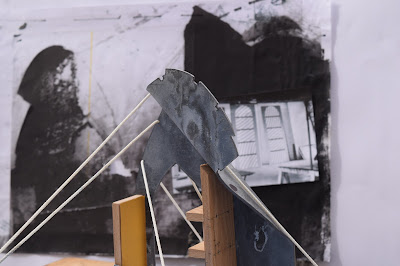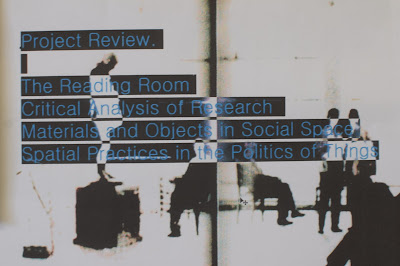Structural Modalities/Making/Tensions : Spatial Forms to gather/interact with discursive research.
https://www.flickr.com/photos/russellmoreton/24337820341/in/dateposted-public/
Poetics/Architecture : The scriptorium as an architectural surround.
5
Procedural Architecture
Start by thinking of architecture as a tentative constructing toward a holding in place. Architecture's holding in place occurs within and as part of a prevailing atmospheric condition that others routinely call biosphere but which we, feeling the need to stress its dynamic nature, have renamed bioscleave.
Architectural Body
Madeline Gins and Arakawa
Working Notes/Holding in Place
Entanglement of Matter and Meaning
Intertwining Metamorphoses
Germano Celant
Giuseppe Penone
Diffractions : Differences, Contingencies, and Entanglements That Matter
Meeting The Universe Halfway
Quantum physics and the entanglement of matter and meaning
Karen Barad
Art and Technics
Lewis Mumford
James Turrell
Aten Reign
Miwon Kwon
Under The Volcano
Carmen Gimenez
Kees Goudzwaard
Assemblage
Pinholes and Dust
Grisaille
Transparent Body
Robert Mangold
Column Structure Paintings
Frank Stella Architecture
Architecture as a means towards creating space
The Optical Unconscious
To throw its net over the whole of the external world in order to enter it into consciousness. To think it
Rosalind Krauss
Postproduction
Nicolas Bourriaud
Body
Personal Relations
Spatial Values
Yi-Fu Tuan
Wayfinding/Movements through accumulated research
Running scripts, enactments, instances, involvements
Collaborative texts, complexity, emergent, discursive
From The Bookcase to The Field Table : Landing Sites of Inquiry
Camouflage
Neil Leach
For Benjamin, the twentieth century is an age of alienation. Human beings are no longer 'cocooned' within their dwelling spaces. Architectural spaces are no longer reflections of the human spirit. Something has been lost.
Mimesis, 19.
New Concepts of Architecture
Existence, Space and Architecture
Christian Norberg-Schulz
A child 'concretizes' its existential space.
A Philosophy of Emptiness
Gay Watson
Artistic Emptiness
Everything flows, nothing remains.
Heraclitus
Rethinking Architecture
Neil Leach
Figure 1, Sketch by Jacques Derrida for Choral Work project. 343
Foucault, Figure 2 Bentham's Panopticon (1791). 360
Page laid in, The Atrocity Exhibition by J. G. Ballard, new revised edition,annotations, commentary, illustrations and photos.
Tracing Eisaenman
Plenum, juxtaposed to form/haptic values/body absences
Robert Mangold
Between moments of 'meaning' lie spaces or blanks of immediate experience. Such blanks are actuality. Usually the blank, the actuality, goes unnoticed because it works so efficiently to differentiate one meaningful event from another. Kubler discussed this in The Shape of Time.
Interactions of the Abstract Body
Josiah McElheny
Object Lesson/Heuristic Device
The term 'heuristic' is understood here to denote a method of addressing and solving problems that draws not on logic but on experience, learning and testing. In this regard stories and fictional narratives can be heuristic devices in acting as ideal models that are not to be emulated but which help to situate characters, actions and objects.
Space Between People
Degrees of virtualization
Mario Gerosa
Adaptive Architectural Design
Device-Apparatus
Place
Function
Adaptation
The second phase of project activity acknowledges that the proposal involves two sites; the landscape of settlement and the artifice of the factory. The design is intended to be a reflection of the conditions of each, so there was a need to work directly with the manufacturing process, at full scale, as early as possible. This would provide an immediate counterpoint to the earlier representations and a necessary part of exploring the manufacturing medium in the context of architectural design. 69
Building The Drawing
The Illegal Architect
Immaterial Architecture
Mark Cousins suggests that the discipline of architecture is weak because it involves not just objects but relations between subjects and objects. And if the discipline of architecture is weak, then so, too, is the practice of architects. Architecture must be immaterial and spatially porous, as well as solid and stable where necessary, and so should be the practice of architects.
Jonathan Hill
Index of immaterial architectures
Herzog and De Meuron
Natural History
Exhibiting Herzog and De Meuron
We are not out to fill the exhibition space in the usual manner and to adorn it with records of our architectonic work. Exhibitions of that kind just bore us, since their didactic value would be conveying false information regarding our architecture. People imagine that they can follow the process, from the sketch to the final, photographed work, but in reality nothing has really been understood, all that has happened is that records of an architectural reality have been added together.
My studio is a piece of architecture that is silent. The things of which it is made say all and at the same time nothing. Its strength lies in its demanding silence. A stern silence in order to permit works to occur. I imagine that a painting by Newman could be hung there.
The arrival of Beuys in a world that was gradually falling asleep amidst minimalism generated a kind of confusion that was truly excellent for opening up the mind. Comfort vanished, driven away by subversive complexity.
Speculative architecture
On the aesthetics of Herzog and De Meuron
Without opposition nothing is revealed,
no image appears in a clear mirror
if one side is not darkened
Jacob Bohme, De tribus principii (1619)
Reflections on a photographic medium
Memorial to the Unknown Photographer
Thomas Ruff's Newspaper Photos
Valeria Liebermann
Working Collages
Karl Blossfeldt
Sensing Spaces/Architecture Reimagined
Royal Academy of Arts
Anti Object
We are composed of matter and live in the midst of matter. Our objective should not be to renounce matter, but to search for a form of matter other than objects. What that form is called architecture, gardens, technology is not important.
Kengo Kuma
Body and Perception
The Phenomenon Of Place
Places at the Zero Point
The Box Man
Furnishing the Primitive Hut
An Architecture of the Seven Senses
Walter Pichler
Architect/Sculptor
The Thinking Hand
Existential and Embodied Wisdom in Architecture
Encounters
Architectural Essays
Identity, Intimacy and Domicile
Notes on the phenomenology of home
The Architecture of Image/Existential Space in Cinema
Lived space in Architecture and cinema
The Eyes Of The Skin/Architecture and the Senses
Juhani Pallasmaa
Atlas of Emotion
Journeys in Art, Architecture and Film
Giuliana Bruno
Questions Of Perception
Phenomenology Of Architecture
Steven Holl
Juhani Pallasmaa
Alberto Perez-Gomez
Materials and Meaning in Architecture
Essays on the Bodily Experience of Buildings
Nathaniel Coleman
Matter and Desire
An Erotic Ecology
Andreas Weber
Visualizing Feeling
Affect and the feminine avant-garde
Susan Best
Making/Anthropology, Archaeology/Art and Architecture
Being Alive/Essays On Movement
Knowledge and Description
Tim Ingold
Thinking Through Craft
Glenn Adamson
The Ceramic Process
A manual and source of inspiration for ceramic art and design
European Ceramic Work Centre
A Hut Of One's Own
Ann Cline
Smithson, Alison and Peter
Solar Pavilion
Architecture is not made with the brain
Architectural Association
The Kunsthaus Bregenz as an Architecture of Art
The Conditioning of Perception
Multiplicity and Memory
Hortus Conclusus
Thinking Architecture
Peter Zumthor
Re-Shaping Learning
A Critical Reader
The Future of Learning Spaces in Post-Compulsory Education
Anne Boddington, Jos Boys
Hiding, Making, Showing, Creation
The Studio from Turner to Tacita Dean
Rachel Esner
Conversations With Strangers
Performing the broom and the bricoleur
Malcolm Doidge
Corpus
The Ground of the Image
Jean-Luc Nancy
Life Between Buildings/Parking Day Manifesto
Poststructuralism, a very short introduction
Mapping Intermediality in Performance/Intermedia Chart
Sarah Bay-Cheng
Liminality, a psychological, neurological, or metaphysical subjective, conscious state of being on the 'threshold' of or between two different existential planes.
Heidegger for Architects/Emotions Building Presence
Adam Sharr
The Visual Poetics of Jannis Kounellis
Suzanne Cotter, Andrew Nairne
Carlo Scarpa
Craft Intensive/Spaces, Vistas
Technical specifications of materials
Site-Specific Art/Tschumi, Robert Morris, Robert Smithson, Giuseppe Penone
Performance, Place and Documentation/Material Affects, Frames, Site, Spaces
What is the relationship between the visual arts and 'performativity'?
Nick Kaye
Wittgenstein, The Duty of Genius
Oren Lieberman/Spatial Practices/What does it Do?
These remarks show the unmistakable influence of Schopenhauer. In the World as Will and Representation, Schopenhauer discusses, in a remarkably similar way, a form of contemplation in which we relinquish 'the ordinary way of considering things', and 'no longer consider the where, the when, the why, and the whither in things, but simply the what. 143
.jpg)
.jpg)
.jpg)


.jpg)


